法律英语沙丽金版阅读文本问题答案
- 格式:docx
- 大小:29.03 KB
- 文档页数:12
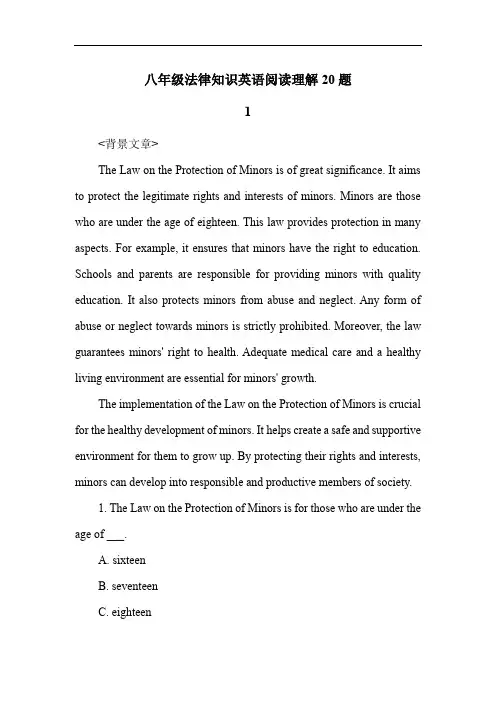
八年级法律知识英语阅读理解20题1<背景文章>The Law on the Protection of Minors is of great significance. It aims to protect the legitimate rights and interests of minors. Minors are those who are under the age of eighteen. This law provides protection in many aspects. For example, it ensures that minors have the right to education. Schools and parents are responsible for providing minors with quality education. It also protects minors from abuse and neglect. Any form of abuse or neglect towards minors is strictly prohibited. Moreover, the law guarantees minors' right to health. Adequate medical care and a healthy living environment are essential for minors' growth.The implementation of the Law on the Protection of Minors is crucial for the healthy development of minors. It helps create a safe and supportive environment for them to grow up. By protecting their rights and interests, minors can develop into responsible and productive members of society.1. The Law on the Protection of Minors is for those who are under the age of ___.A. sixteenB. seventeenC. eighteenD. nineteen答案:C。
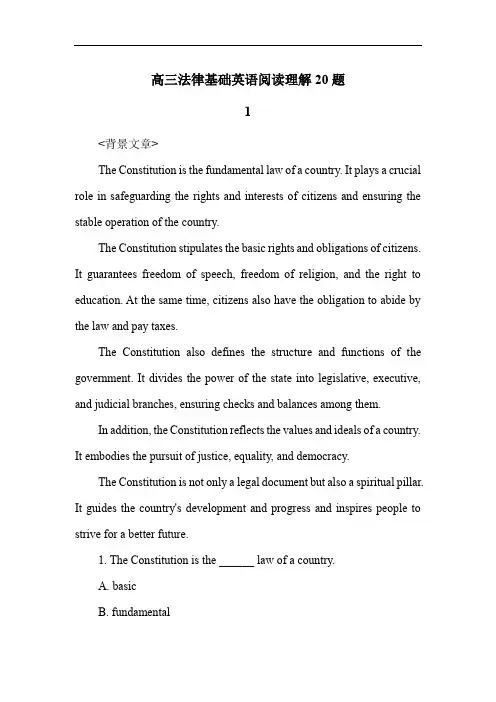
高三法律基础英语阅读理解20题1<背景文章>The Constitution is the fundamental law of a country. It plays a crucial role in safeguarding the rights and interests of citizens and ensuring the stable operation of the country.The Constitution stipulates the basic rights and obligations of citizens. It guarantees freedom of speech, freedom of religion, and the right to education. At the same time, citizens also have the obligation to abide by the law and pay taxes.The Constitution also defines the structure and functions of the government. It divides the power of the state into legislative, executive, and judicial branches, ensuring checks and balances among them.In addition, the Constitution reflects the values and ideals of a country. It embodies the pursuit of justice, equality, and democracy.The Constitution is not only a legal document but also a spiritual pillar. It guides the country's development and progress and inspires people to strive for a better future.1. The Constitution is the ______ law of a country.A. basicB. fundamentalC. importantD. secondary答案:B。
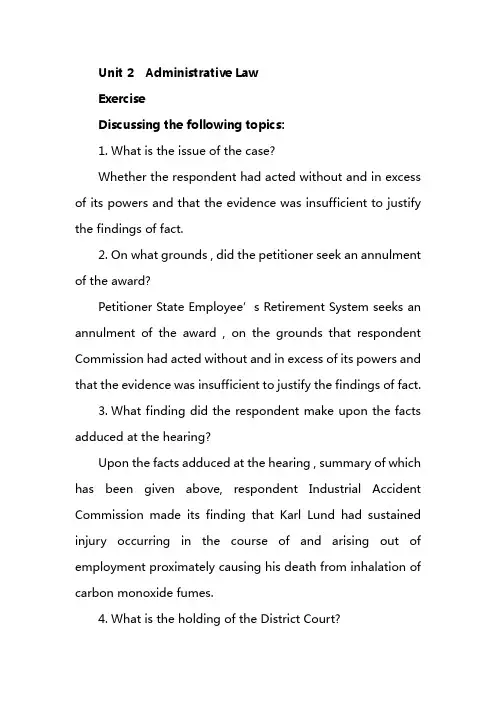
Unit 2 Administrative LawExerciseDiscussing the following topics:1.What is the issue of the case?Whether the respondent had acted without and in excess of its powers and that the evidence was insufficient to justify the findings of fact.2.On what grounds , did the petitioner seek an annulment of the award?Petitioner State Employee’s Retirement System seeks an annulment of the award , on the grounds that respondent Commission had acted without and in excess of its powers and that the evidence was insufficient to justify the findings of fact.3.What finding did the respondent make upon the facts adduced at the hearing?Upon the facts adduced at the hearing , summary of which has been given above, respondent Industrial Accident Commission made its finding that Karl Lund had sustained injury occurring in the course of and arising out of employment proximately causing his death from inhalation of carbon monoxide fumes.4.What is the holding of the District Court?The District Court of Appeal held that death arose out of and inthe course of employment , and the award is affirmed.5.Why neither awards may be annulled?Because there are two conclusions which fairly may be drawn from the evidence , both of which are reasonable, the one sustaining the other opposing the right to compensation . Nor may an award be rejected solely on the basis of moral or ethical considerations.P28 exercisesDiscussing the following topics;1.What is the issue of this case?Whether or not to allow a deportable alien to leave the country voluntarily.2.What is the opinion of the Court of Appeals?Exarchou has sustained his burden of established good moral character under s 19 (c) of the Immigration Act of 1917 , former 8 U.S.C.155 (c) ,and is entitled to further consideration of his application . Whether any other factors may warrant the Service in not following its 1951 and 1953 grants of discretionary relief to Exarchou is not now before us.3.The Immigration and Naturalization Service granted the Relator --Appellant Permission twice for relief he now seeks , what are they?In March 1951 , following the initial determination of his deportability ,it recommended that his deportation should be suspended. And for the second time ,the Service granted him permission to depart from the country voluntarily.4.What is the decision of the Special Inquiry Office upon the investigation of Immigration and Naturalization Service?The Special Inquiry Officer , reversing the Service’s earlier position , found that Exarchou had not sustained his burden of proof as to good moral character and hence was ineligible for the exercise of discretion which would allow him to depart from voluntarily.5.Why did the court reverse the shift of position of the Service?The evidence is not sufficient to justify the Service’s present shift to position as to Exarchou’s good moral character.Unit 3 Antitrust Law P 37Discussing the following topics1. What is the cause of action of the lawsuit brought by the United States against Sealy, Inc.?The United States alleged that Sealy ,Inc.had violated 1 of the Sherman Act , 26 Stat.209 , as amended , 15 U.S. C. 1, by conspiring with its licensees to fix the prices at which the retailcustomers of the licensees might resell bedding products bearing the Sealy name, and to allocate mutually exclusive territories among such manufacturer --licensees.2.What did the trial court find?The District Court found that Sealy Inc.was engaged in a continuing conspiracy with its manufacturer --licensees to agree upon and fix minimum retail prices on Sealy products and to police the prices so fixed . However , the trial court held that the US had not proved conduct in unreasonable restraint of trade in violation of Sherman Act with respect to its allegation that Sealy Inc.conspired to allocate mutually exclusive territory among its manufacturers.3.What did the trial court rule on Sealy Inc. ‘s price--fixing activities?It enjoined Sealy Inc.from conspiracy of price-fixing.4.What is the issue for the Court to decide?Whether the appellee conspired to allocate mutually exclusive territory among its manufacturers。
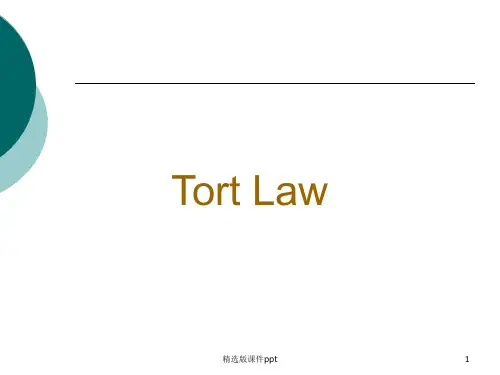
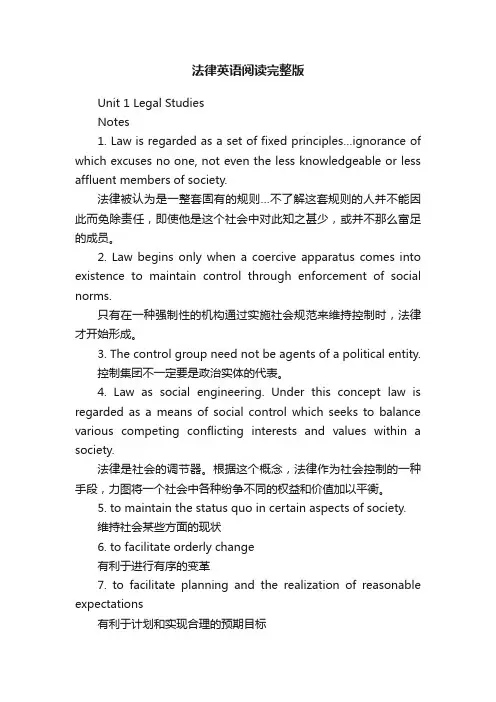
法律英语阅读完整版Unit 1 Legal StudiesNotes1. Law is regarded as a set of fixed principles…ignorance of which excuses no one, not even the less knowledgeable or less affluent members of society.法律被认为是一整套固有的规则…不了解这套规则的人并不能因此而免除责任,即使他是这个社会中对此知之甚少,或并不那么富足的成员。
2. Law begins only when a coercive apparatus comes into existence to maintain control through enforcement of social norms.只有在一种强制性的机构通过实施社会规范来维持控制时,法律才开始形成。
3. The control group need not be agents of a political entity.控制集团不一定要是政治实体的代表。
4. Law as social engineering. Under this concept law is regarded as a means of social control which seeks to balance various competing conflicting interests and values within a society.法律是社会的调节器。
根据这个概念,法律作为社会控制的一种手段,力图将一个社会中各种纷争不同的权益和价值加以平衡。
5. to maintain the status quo in certain aspects of society.维持社会某些方面的现状6. to facilitate orderly change有利于进行有序的变革7. to facilitate planning and the realization of reasonable expectations有利于计划和实现合理的预期目标8. Courts will not turn to case decision for law if a statute is directly in point..如果某一成文法条直接适用,法院不会到判例中去寻找法律依据。
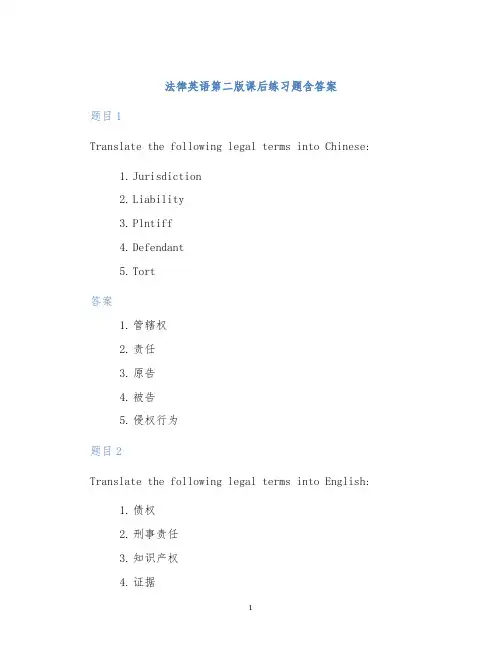
法律英语第二版课后练习题含答案题目1Translate the following legal terms into Chinese:1.Jurisdiction2.Liability3.Plntiff4.Defendant5.Tort答案1.管辖权2.责任3.原告4.被告5.侵权行为题目2Translate the following legal terms into English:1.债权2.刑事责任3.知识产权4.证据5.公正答案1.Debt rights2.Criminal liability3.Intellectual property rights4.Evidence5.Frness题目3Choose the appropriate legal term to complete the sentence: The ___________ is the person who is accused of a crime.1.Plntiff2.Defendant3.Jurisdiction4.Liability5.Tortfeasor答案2.Defendant题目4Choose the appropriate legal term to complete the sentence:A ____________ is a legal document that gives a person the right to perform a specific action.1.Liability2.Jurisdiction3.Power of Attorney4.Plntiff5.Defendant答案3.Power of Attorney题目5Match the following legal terms with their definitions:1.Tort2.Liability3.Jurisdiction4.Plntiff5.Defendanta.A civil wrong that causes harm or injury to someoneb.The legal responsibility for one’s actionsc.The power or authority of a court to hear anddecide a cased.The person who initiates a lawsuite.The person who is accused of a crime or sued in acivil lawsuit答案1.a2.b3.c4.d5.e题目6Translate the following sentence into English:根据法律,契约是双方当事人自愿达成的双方都必须履行的协议。
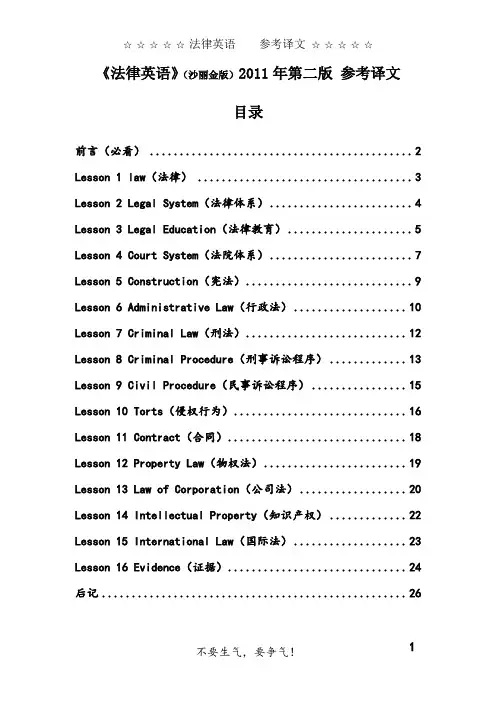
《法律英语》(沙丽金版)2011年第二版参考译文目录前言(必看) (2)Lesson 1 law(法律) (3)Lesson 2 Legal System(法律体系) (4)Lesson 3 Legal Education(法律教育) (5)Lesson 4 Court System(法院体系) (7)Lesson 5 Construction(宪法) (9)Lesson 6 Administrative Law(行政法) (10)Lesson 7 Criminal Law(刑法) (12)Lesson 8 Criminal Procedure(刑事诉讼程序) (13)Lesson 9 Civil Procedure(民事诉讼程序) (15)Lesson 10 Torts(侵权行为) (16)Lesson 11 Contract(合同) (18)Lesson 12 Property Law(物权法) (19)Lesson 13 Law of Corporation(公司法) (20)Lesson 14 Intellectual Property(知识产权) (22)Lesson 15 International Law(国际法) (23)Lesson 16 Evidence(证据) (24)后记 (26)前言(必看)1、此翻译并非权威翻译,而是技术含量不高的译文。
其中肯定有很多不恰当甚至错误的地方,所以仅供参考,欢迎各位同学指正。
(新浪微博2、制作本译文动力源于兴趣,目的在于互相交流学习。
3、如果你只是想以此译文来应付老师上课的抽问,那么你大可不必下载或复制此文档,因为这样你对不起你自己。
4、本译文=老师的长难句注解(即划线部分。
我无意间在网上找到了部分老师传到网上的注解文档。
O(∩_∩)O )+1位往届同学的翻译+1位同届同学的翻译+课堂笔记+本人拙译(虽然本人英语不怎么好,但我会尽最大努力与大家分享所学到的知识)。
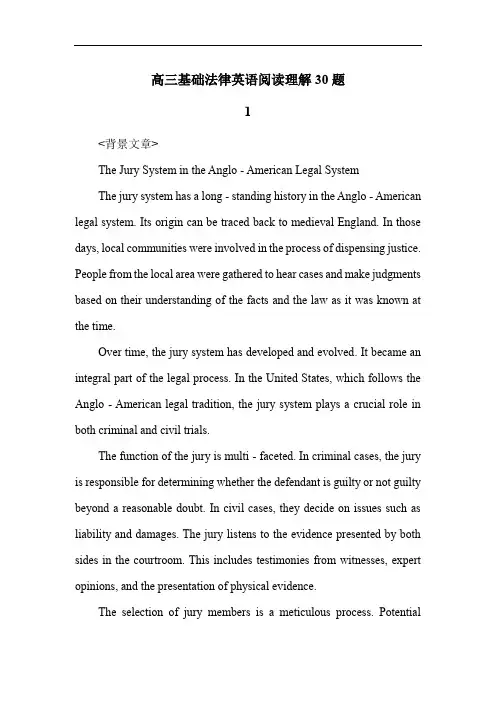
高三基础法律英语阅读理解30题1<背景文章>The Jury System in the Anglo - American Legal SystemThe jury system has a long - standing history in the Anglo - American legal system. Its origin can be traced back to medieval England. In those days, local communities were involved in the process of dispensing justice. People from the local area were gathered to hear cases and make judgments based on their understanding of the facts and the law as it was known at the time.Over time, the jury system has developed and evolved. It became an integral part of the legal process. In the United States, which follows the Anglo - American legal tradition, the jury system plays a crucial role in both criminal and civil trials.The function of the jury is multi - faceted. In criminal cases, the jury is responsible for determining whether the defendant is guilty or not guilty beyond a reasonable doubt. In civil cases, they decide on issues such as liability and damages. The jury listens to the evidence presented by both sides in the courtroom. This includes testimonies from witnesses, expert opinions, and the presentation of physical evidence.The selection of jury members is a meticulous process. Potentialjurors are randomly selected from the local population. They are then summoned to the courthouse. During the selection process, known as voir dire, both the prosecution and the defense have the opportunity to question the potential jurors. This is done to ensure that the jurors are impartial and can make a fair decision. They can exclude certain jurors for various reasons, such as if they have a pre - existing bias or if they are related to one of the parties involved in the case.In the modern judicial system, the jury system still holds significant importance. It represents the voice of the community in the courtroom. It provides a check on the power of the judiciary and the prosecution. By involving ordinary citizens in the decision - making process, it gives the public a sense of participation in the justice system. However, it also faces some challenges. For example, the process can be time - consuming and costly. There are also concerns about the ability of jurors to fully understand complex legal issues.1. What is the origin of the jury system in the Anglo - American legal system?A. It originated from ancient Rome.B. It can be traced back to medieval England.C. It started in the United States in the 18th century.D. It has no clear origin.答案:B。
Law1.What’s the relationship between civilization and law?The fairness of a nation’s laws and the extent to which the legal system justly administers the laws is a measure of the enlightenment, humanity, and degree of civilization of its people.2.What’s law?Law consists of the whole body of rules applied and enforced under the authority of established government in determining what conduct is proper and should be permitted and that which should be denied or penalized.3.Can you list the roles of law in society?Without law, there would be anarchy. Law is the means through which society is able to exist by providing protection for the individual; by establishing and maintaining order, health, and safety; by providing a peaceful means of dispute resolution; by providing stability and flexibility in economic relations between people; and by prohibiting conduct destructive to society.4. How can law be best understood?Law is best understood by viewing the legal system as a process——a means of pulling together society’s needs and goals and translating them into guides for fairness and reasonableness in conduct.5. What are the events that promote the development of the English legal system? Norman Conquest. William replaced the local and highly varied systems of law with a mon system of law.6. Why did the people in England petition to the King and what would be the result? Because of the extremely rigid, frequently overly technical procedural requirements of the mon-law system, people were sometimes unable to obtain fair relief in the courts. In time, some persons who felt that the form of relief was inadequate petitioned to the King directly.This practice gave rise to a second court system, called the Court of Chancery.7. What was the situation of equity courts in North America?American court systems in the nineteenth century resulted in simplification of judicial procedures and elimination of equity courts as separate courts in most states.8.Was the statutes developed fast in North America? Why?9. What are the disadvantages of statues and the advantages of the mon law rules?10. Who has the power to make the ordinances?The legislative body of a municipal corporationLegal System1.What is the relationship between the civil law system and Roman Law?The civil law is based on Roman Law.2.Who is the Justinian and what is his contribution?Byzantium Emperor.piling codes after the enthronement3.Which is the primary source of law in Europe, Roman Law or local laws?Local customs4.Why was the concept of codification developed in the 17th and 18th centuries?As an expression of both Natural Law and the ideas of the Enlightenment.5.What did the opponents of codification think about codification of law?Its opponents claimed that codification would result into the ossification of law.6.What is the main feature of mon law?Its inclusion of extensive non-statutory law reflecting precedent derived from centuries of judgments by working jurists.7.What is the difference between statutes and regulations?Statues are enacted by a legislature, while regulations are promulgated by executive branch agencies pursuant to a delegation of rule-making authority from a legislature.8.Where should people go if they wanted to apply for injunctions before the 20thcentury? Why?Courts of equity. Only courts of equity have the authority to do it.9.What is the difference between the selections of judges in civil law countries andthat in mon law countries?Civil law judges are usually trained and promoted separately from advocates, whereas mon law judges are usually selected from acplished and reputable advocates.10.What are the differences in the criminal procedures of the two major legal systems?In general, the judge in a civil law system plays a more active role in determining the facts of the case. Most civil law countries investigate major crimes using a so-called inquisitorial system. Also, civil law systems rely much more on written argumentthan oral argument.Court System1.What is the main characteristic of the court system of the United States?Courts are operated in both state and federal governments.2.Are there any uniform rules for creating state courts?No. but it has a general pattern.3.What are the functions of the inferior courts at the bottom of the state judicialhierarchy?Trying minor civil cases involving small sums of money, and minor criminal cases involving light penalties and conducing preliminary hearings in the more serious criminal cases.4.Do all states have the same terminology for courts and judges? Please giveexamples.No. For examples, a man who sits on the highest court of New Jersey is called a justice of the supreme court of that state, while a man who holds an equivalent position in New York is called a judge of the court of appeals.5.What are the duties of the judges who sit on appellate courts?They do no trial work, being occupied exclusively in hearing appeals. They review the proceedings of trial courts upon the basis of written records. They hear oral arguments and read written arguments, called briefs, in an effort to discover whether errors were mitted in the trial court of such a nature as to require reversal of the judgment or a new trial.6.How many tiers of courts are there in the federal court system in the U.S.? What arethey?There are three levels of courts: trial, intermediate appellate and top appellate.7.Does each state have a federal trial court? What decides the number of the federaltrial court in each state?Each state has at least one United States district court.The population of the district8.What types of cases will be tried by federal courts?Prosecutions for federal crimes civil claims based upon federal lawcivil claims between citizens of civil actions.9.Which authority has the power to create federal circuit courts?Congress10.Does the Supreme Court of the U.S. review all the cases appealed? Dose theSupreme Court of the U.S. have the power to review all the decisions made by the state highest courts?No. Yes.Constitution1.What are usually established in a constitution?A constitution establishes the rules and principles by which an organization, orpolitical entity, is governed. In the case of countries, this term refers specifically to a national constitution, which defines the fundamental political principles and establishes the power and duties of each government.2.What are the examples that show the limitation imposed by the constitution to theorganizations in the United States?An example from the constitutional law of nation-states would be a provincial government in a federal state trying to legislate in an area exclusively enumerated to the federal government in the constitution.3.What are the relationships regulated by the U.S. Constitution?The relationship among institutions of the state. In a basic sense the relationship among the executive, legislative and the judiciary, but also the relationship of institutions within those branches.4.How do you describe an uncodified constitution?An uncodified constitution is one that is not contained in a single document, consisting of several different sources, which may be written or unwritten.5.Why is an unwritten constitution not an accurate synonym for uncodifiedconstitution?Because all modern democratic constitutions consist of some written sources,6.What do the codified and uncodified constitutions respectively result from?Codified constitutionsare usually the product of dramatic political change, such as revolution. Uncodified constitutions are the product of an “evolution”of laws andconventions over centuries.7.Is it easy to amend a constitution? Why or why not?No. an extraordinary procedure is required for constitutional amendments involve some procedures that makes obtaining a constitutional amendment more difficult than passing a simple law.8.What happens if there are conflicts between the constitution and a statute in acountry using codified constitution?All or part of the statue can be declared ultra vires by a court and struck down as unconstitutional.9.What are the sources of uncodified constitution of Britain?Written sources: e.g. constitutional statues enacted by the Parliament and also unwritten sources: constitutional conventions, observation of precedents, royal prerogatives, customs and traditions.10.Are there any differences between the constitutional law and statutory law in statesusing uncodified constitutions?No. Both can be altered or repealed by a simple majority in Parliament.Criminal Law1.Who do ordinary people think of crimes?People think of crimes as acts that threaten public safety, security or morality.Crime can be defined as anti-social conduct that is sufficiently serious to require state intervention and punishment.2.What is the accurate definition of crime?A crime is any act or omission that is contrary to the criminal law.3.What are the elements that may establish a crime?Criminal liability, guilty mind,4.What is the standard of proof for the prosecution to prove that a person is guilty?Beyond a reasonable doubt that the defendant mitted the actus reus of the crime, while at the same time having the required mens rea5.What does the actus reus include?Conduct, circumstance and consequence6.Will all omissions lead to liability?No7.What are the circumstances where criminal liability has been imposed for anomission?8.What is shared by the cases about omission?A defendant has accepted or been placed under a duty to act, and his/her omissionconstitutes a failure to discharge that duty— the omission is no longer pure.9.In what kind of cases is causation required?The defendant’s conduct caused the unlawful consequence10.How is the subjective nature of criminal liability proved?Show a criminal state of mindCriminal Procedure1.What is the function of criminal procedure law?The law governing the series of procedures through which the substantive criminal law is enforced.2.What are the sources of criminal procedure law?The United States Constitution, (2) federal statutes (3) the Federal Rules of Criminal Procedure (d) local district court rules (e) rulings of federal courts based on their mon law decisional authority or their supervisory authority over the administration of criminal justice in the federal courts (f) the internal regulations of the Department of Justice and other agencies involved in the administration of the federal process.3.What is a known offence?Where the police conclude that a crime may well have been mitted, it will be recorded as a “known offence”4.Who has the power to conduct investigation before arrest?Police, prosecutorial and other non-police investigations5.What are usually done in the process of booking?The arrestee’s name, the time of his arrival, the offense for which he was arrested are noted in the police “log”, the arrestee also will be photographed and fingerprinted.6.How many types of charging instruments are there in the felony cases?plaint information, indictment7.Are there any differences between First Appearance and Preliminary Hearing?8.What will be done in the process of a grand jury review?Determining whether there is sufficient evidence to justify a trial on the charge sought by the prosecution. If a majority of the grand jurors conclude that the prosecution’s evidence is sufficient, they will issue the indictment requested by the prosecutor.9.What are the characteristics of criminal trial?(a)the presumption of defendant’s innocence (b) the requirement of proof beyonda reasonable doubt (c) the right of the defendant not to take the stand (d) theexclusion of evidence obtained by the state in an illegal manner10.How many types of sentences are used in criminal cases?Financial sanctions, some form of release into the munity, and incarceration in a jail or prisonCivil Procedure1.How do people resolve their disputes?One is to engage in “self-help”, by which you redress the wrong personally. Another is to contact the person who harmed you and demand some pensation or other remedies.2.Which way of settling disputes is acceptable in the society?Litigation3.Why is litigation a publicly funded dispute resolution?The taxpayers provide the courtroom, the judge, and the instrumentalities by which the dispute is resolved.4.Who usually initiates a civil litigation, a government or an individual?Individual5.Is civil litigation time consuming? Why?Yes. Because there are many more parts to the process than the trial,6.Why is the question of forum selection important?The decision implicates a variety of important doctrines. And there are questions of tactics and ideal for the defendant.7.What should be decided by a plaintiff and his /her lawyer before filing a suit?What to put in the plaint.8.Where can the elements of claims be found?Substantive law9.What is the function of civil procedure law?Civil procedure provides the mechanism—the process—by which disputes over such substantive claims are resolved. It provides a theoretically content-neutral mechanism for resolving disagreements. It establishes the method by which someone would vindicate a right given to her by the law.10.What are the stages in civil litigation?Pleadings, motions, discovery, possible pretrial adjudication, conferences, and meetingsTorts1.What are the functions of tort law?The purpose of torts is to pensate an injured party through the award of damages for the injuries incurred during a tortious act.2.What is the difference between a tort and a crime?The difference is that a tort is a wrong against an individual, whereas a crime is a wrong against society as a whole.3.How do you prove the intent of a defendant?Intent is most often proved through circumstantial evidence: the defendant’s conduct, in the context of his or her surroundings and what he or she presumably knew and perceived.4.What are the elements of false imprisonment?(a)Intent to confine a person within a certain area (b) actual confinement(c) Awareness of plaintiff of the confinement or injury to plaintiff due to confinement;and (d) Prevention of exit or no safe exit possible by plaintiff5.What needs to be proved in case of trespass?An act, coupled with the intent to cause entry by the defendant, and an invasion of the plaintiff’s land6.What does standard of care mean?As a general rule, all persons are under a duty to conduct themselves in such amanner as not to create unreasonable risks of physical harm to others.7.How do you make defense for a negligent conduct?Contributory or parative negligence and assumption of the risk8.What is the difference between the two types of parative negligence?Pure parative negligence simply means that if a plaintiff is 90 percent at fault, he or she can still recover 10 percent. Another name for partial parative negligence is 50percent rule, which means that if the plaintiff is more than 50 percent at fault, he or she cannot recover.9.In what situation is the defense of assumption of risk applied?The plaintiff’s own actions trigger this defense, which is the plaintiff’s knowing and voluntary consent to encountering a known danger.10.Can a plaintiff get recovery if the defendant has no fault under strict liability doctrine?Why?Yes. Legal fault stems from a deviation from a standard of conduct needed to protect society and its citizens.Contact1.In what situation is there an implied contract?An implied contract is one that is inferred from the conduct of the parties.2.What is the difference between bilateral contracts and unilateral contracts?A bilateral contract is one in which the parties exchange promises to do some futureact. A unilateral contract is one in which one party acts immediately in response to the offer. The response is in the form of immediate action rather than a mutual exchange of promises.3.What is the difference between a void contract and a voidable contract?A void contract is a nullity from its beginning, and damages do not result. Avoidable contract is one that is binding until it is disaffirmed or canceled by the party with the authority to do so.4.What are the key elements for the formation of a contract?(1)the capacity of parties; (2) offer and acceptance (3) Consideration5.How does a corporation enter into a contract?The law creates a legal fiction that corporations are persons.6.Are the shareholders of a corporation involved in the contract concluded by thecorporation?No.This device allows corporations to sue and be sued and to conduct business transactions as entities without involving individual shareholders.7.What may decide the capacity of a person to enter into a contract?The age of the individual or from a party’s being mentally incapable of understanding the ramifications 后果of the contract8.Are there any special provisions about minors’ making contract? What are they?Minors are under an obligation to return any consideration received under the contract9.How can misunderstandings about terms in plex contracts be avoided?plex contracts often contain sections that clearly define certain terms.10.How do you decide whether the two parties of a contract have the mutualagreement?On an objective standard, and the subjective intent of the parties is usually irrelevantLaw of Corporation1.Why was the corporation proved to be an ideal instrument for the industrialdevelopment?It could raise large amounts of capital from numerous investors and yet provide centralized direction of large industrial concerns.2.Who has the power to approve the individual corporate charter originally?State legislatures3.Which state is the winner in the race of attracting panies?Delaware4.What is the procedure for the formation of a corporation?Filing an appropriate document with a state official, and paying the appropriate fee 5.What can corporations do as artificial persons?The artificial person may conduct a business or businesses in its own name much in the same way that a “real” person could.6.What is the most obvious advantage that a corporation has?The corporation is unlimitedly liable for the debts and obligations of the business but the shareholders are not, since in theory all debts are the artificial entity’s obligations, not the shareholders.7.Why does a corporation have continuity of life?The existence of the corporation is not dependent on who the owners or investors are at any time. If shareholders die, or decide to sell out, the corporation continues to exist as a separate entity.8.How do you understand the sentence “the corporation does not have a limited lifespan”?It does not really mean that all corporations will continue until the end of time but rather that a corporation will continue indefinitely until the owners decide to dissolve it or merge it into another business.9.What rights do shareholders have?Very specific rights such as a limited right to inspect the books and records of the corporation10.Who has the right to decide the transfer of shareholders’ ownership of interests?oneselfIntellectual Property1.How are intellectual property and intellectual rights defined?Products of the mind: inventions, literary and artistic works, any symbols, names, images, and designs used in merce.Rights given to people over the creation of their minds2.Are “ideas” the product of the mind? And are the “ideas” protected by intellectualproperty law?Yes, no3.What do the various kinds of intellectual property have in mon?Patents, copyrights, industrial designs, trademarks and confidential information 4.Why do the intellectual property rights have much in mon with the rights associatedwith real property?Intellectual property rights can be assigned or bequeathed.Intellectual property is itself intangible, it will be embodied in real objects.5.Do the different intellectual property rights have the same history? Why?Each of the diverse intellectual property rights has its own separate history.6.What is the shaping of the intellectual property law closely related to?Change economic and social conditions7.Are there any differences in the attitudes towards intellectual property rights? Whatare they?Important economic assets rewards for mental laborA reward for individual creativity products of the market8.In what way the ownership in intellectual property is limited?Time9.How are most intellectual property actions settled?Most are settled at the pre-trial stage and the usual remedy, where the claimant is successful, is a permanent injunction together with costs.10.What are the remedies in intellectual property cases?Delivery up, damages and an account of profits。